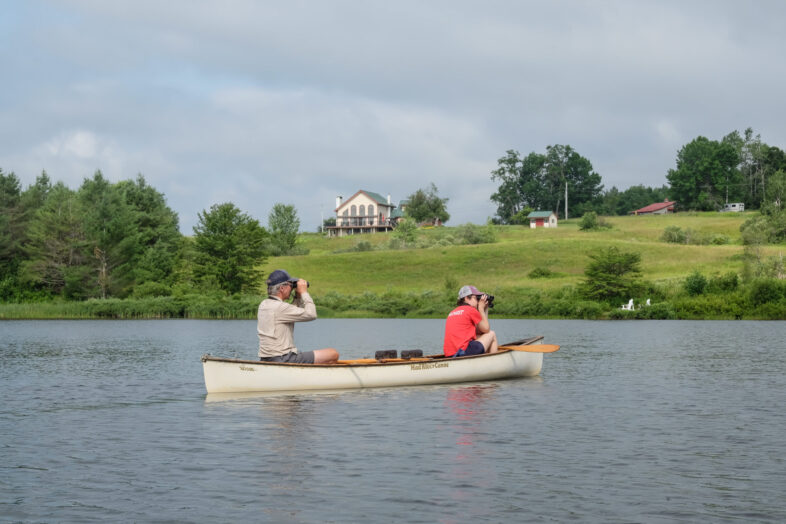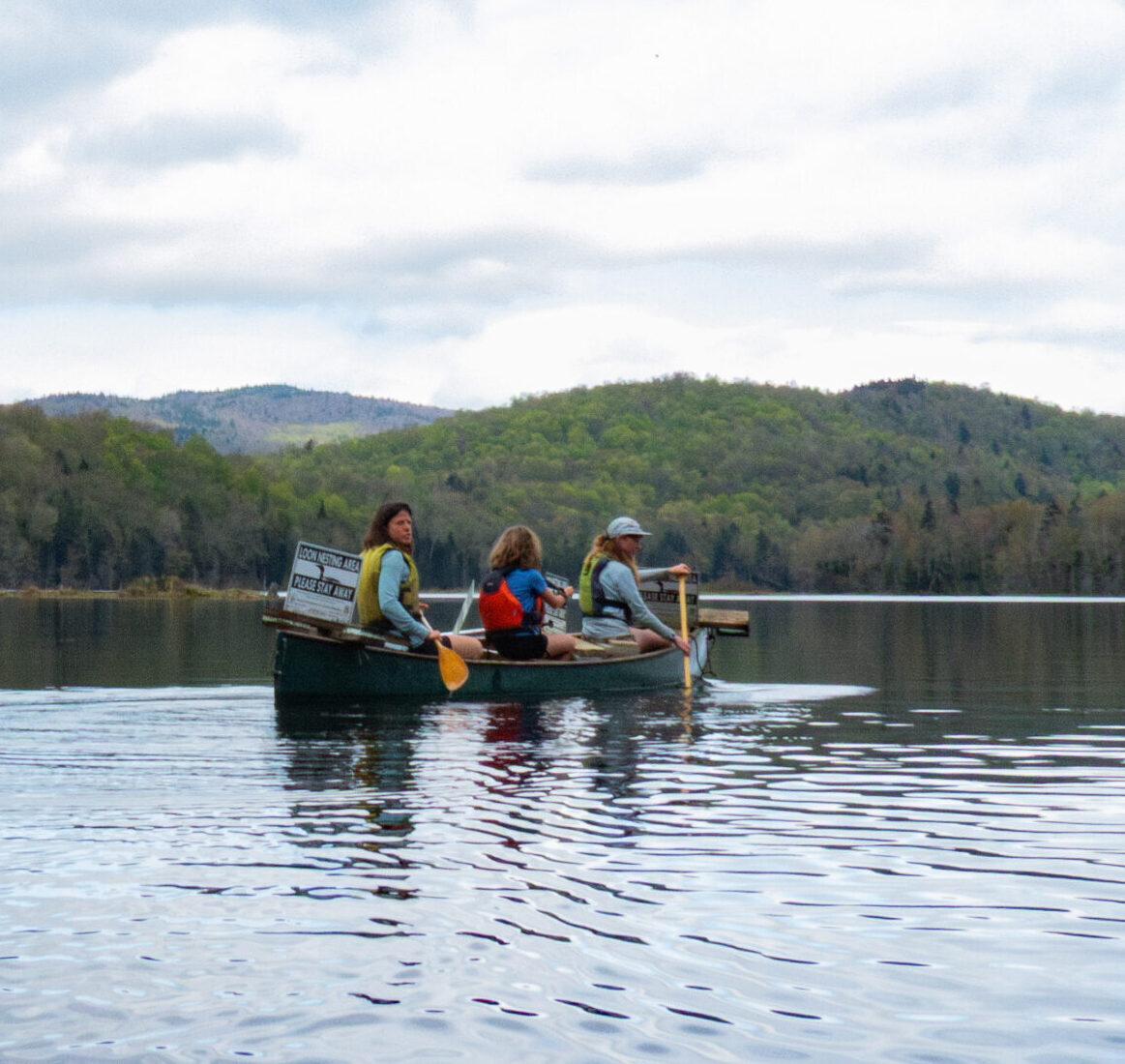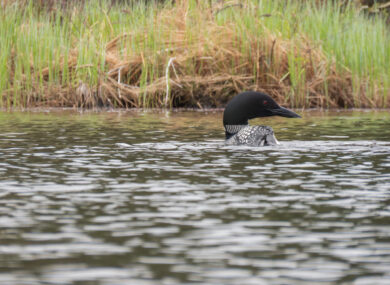
VCE loon biologist Eric Hanson and intern Isabella Soddu search for loons on Colby Pond. © Alden Wicker
Sammi Rizzo is one of VCE’s two interdisciplinary interns for summer 2025, and is involved in several projects, including the Vermont Loon Conservation Project, grassland management, on-farm pollinators, the Native Plants and Pollinators Ecotype Project, and the Second Vermont Butterfly Atlas.
Jobs Pond was our last stop on a long day spent searching for loons. We interns plus Vermont Center for Ecostudies’ loon biologist Eric Hanson had been up since the early hours of the morning, traveling among the many lakes and ponds scattered across Vermont to track down these elusive birds. We knew there was a loon pair here, and our goal was to see if they had built a nest.

Loon nest © Alden Wicker
This isn’t necessarily an easy task. The Common Loon builds its mounded nest low and near the water so that the birds, incapable of walking upright, can reach it; it’s often disguised within the tall vegetation that lines the shallows. Without the distinctive black-and-white shape of a parent sitting on the nest, it would be nearly indistinguishable from one of the many mounds of dirt and grass that we paddled past.
As beautiful as this pond is, tucked in among the cedars and hemlocks with cliffs and mountains rising on the horizon, it felt as though it was working against us. After nearly 30 minutes and a full circuit of the shoreline in our boats, we had spotted just one loon and no nest. Turning back to paddle to shore, we battled through a sudden assault of wind so strong it started to push one canoe containing the other three interns backwards. We struggled through, and the wind calmed just as the end of my kayak bumped against solid land.
But as we gathered at the boat launch, something unexpected happened.
We struck up a conversation with the only other person on the lake, a paddler out to enjoy the natural scenery, and mentioned our work with VCE and loon monitoring. Sadly, we told her, the status of this lake would be a big ol’ question mark. The paddler looked surprised at this—she told us that she wasn’t totally sure what a loon looks like, but she had definitely seen a bird sitting on a nest as she did her loop of the lake!
Eric got back in his kayak and paddled over to where she pointed, and there it was. The loon must have either been off the nest as we searched or hunkered down in such a position that it was difficult to see. We passed within 100 meters and never knew. Without the help of this friendly stranger, we would have missed the nest entirely on this visit.

VCE Loon Biologist Eloise Girard leads a group of volunteers posting signs on the Green River Reservoir. © Fiona Lee MacLean
Loon surveying for VCE’s Loon Conservation Project is a time-consuming task, between all of the paddling and what seems like an hour-long drive minimum to get anywhere on Vermont back roads. On that 10-hour work day, we managed to visit only six of the more than 800 lakes and ponds in the state. Those lakes and ponds support a now-thriving loon population, with 157 pairs and 368 adults counted last year. The crazy part? All of that monitoring, all spring and summer, is managed by just two people: our professional loon biologists, Eric Hanson and Eloise Girard.
But how can only two scientists keep track of so many birds on so many water bodies, especially when this task is so time consuming? That’s where the Vermonters like the paddler we met come in. The current success of this project would be impossible without community participation: regular people, all across the state, out to enjoy the wonder of our waters—people who contribute to science at the same time.
Right now, Eric estimates that there are around 350 volunteers contributing to both LoonCount, a one-day statewide survey in July, and the season-long effort LoonMonitor, with varying degrees of involvement. Over the last 30 years, over 1,500 people have come into contact with the project, whether they’ve just sent in one observation, or have been keeping watch over the same lake for decades.
The whole spectrum of participation is important; the super dedicated volunteers are invaluable and can completely manage their lakes so that Eric and Eloise never need to visit, while the incidental one-time observations can give key hints to where they should be focusing their efforts.
It’s the type of thing that feels like it shouldn’t work: two people, coordinating hundreds of volunteers for months every year, all through one very crowded email inbox. And yet, year after year, work it does. Eric attributes this success both to the captivating charisma of the loon itself and the way that the birds can bring communities together. Noticing the loons for the first time, tracking how they return to the lake every spring, and following the epic highs and lows of their nesting attempts sparks something in people, gives them common ground to connect with their neighbors, and encourages each volunteer to form a deeper connection with their community and the greater natural world.
Just like the Vermont loon population, the future of the project is looking up. VCE is working on a way to streamline the process of recording observations with a tool called LoonWeb. Though Eric hopes to maintain direct contact with volunteers, this should help to clear out that inbox a bit, and will make loon conservation even more accessible to as many people as possible.

Nesting loon on Green River Reservoir, photographed in mid-May during sign posting. © Fiona Lee MacLean
Despite the loons’ amazing recovery from a population of only seven breeding pairs in the entire state 30 years ago, they still face threats, such as flooding and lead fishing gear. Their conservation success so far has been because of the actions of regular people all over the state — and with a bit of help, the Vermont loons can remain a thriving population that we can all be proud of.
You can learn more about Vermont loons at the Vermont Loon Conservation Project page, and make a donation in support of loons at vtecostudies.org/give.

Awesome article!! Working on this project was so fun last summer and great to see how it’s continued 🙂
I had no idea loons have suck interesting nests. I have noticed many more loons in the ADK over the past several years. It is amazing to hear them at night singing to each other.